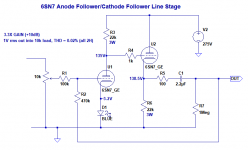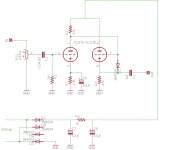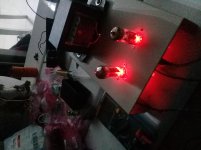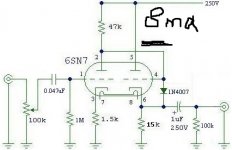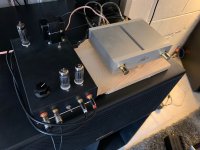How about this?
Not for headphones, though. Not even if the headphones have 300 ohm impedance.
Not for headphones, though. Not even if the headphones have 300 ohm impedance.
Attachments
Last edited:
Well, it seems to work quite well, and drives the 6L6 nicely. Good clean, and linear.I'm not sure I understand what's good about that Blue Velvet circuit. With only 4.5k ohm plate loads, those 6SN7s are being loaded down heavily. I put the circuit into LTspice and it looks like the distortion would be quite high at 1V rms (typical line level) out into normal loads. Am I missing something?
Given, the only test for distortion is my (tin) ear. But the plates don't glow, so I suspect it's not being over worked. 😉
I think its because the low mu of de 6ns7 try with a 12ax7 with that plate resistors and you will get all distorted sound.
I built the Blue Velvet 6sn7 pre amp, for my 6l6 amplifier. It works quite well.
I did, however modify it slightly, by using 12sn7 tubes.
This design looks like someone was going specifically for the "tube sound" and intentionally misloaded the tubes to give lots of lower-order distortion.
Well, it seems to work quite well, and drives the 6L6 nicely. Good clean, and linear.
Given, the only test for distortion is my (tin) ear. But the plates don't glow, so I suspect it's not being over worked. 😉
Eh. It's not that they would glow if run incorrectly, they just wont work as well as they should. They may sound fine, but it would likely be much better with plate loads a decade larger.
I prefer the Blue Velvet topology, avoiding hybrids, SRPP, differential stages, mu followers, voltage followers, feedback, diodes... It is difficult to adequately estimate DC bias levels and load driving capability.
its is a direct coupled design...no need for coupling cap between pins 2 and 4.....
instead of the 1n4007, i use a neon NE-2 lamp...
+1
Yep, that’s better than having the reverse-biased non-linear capacitance of a silicon diode across your grid even if it is helpfully bootstrapped by the cathode.
The shunt capacitance for an extinguished glow lamp varies from 0.5 to 1.5 pF, depending on the size of the electrodes and the pressure of the gas.
Last edited:
I prefer the Blue Velvet topology, avoiding hybrids, SRPP, differential stages, mu followers, voltage followers, feedback, diodes... It is difficult to adequately estimate DC bias levels and load driving capability.
With that many restrictions, I think you've painted yourself into a design corner. There's no way to get a tube to drive a 300 ohm load without negative feedback involved. Remember that a cathode follower is a tube with 100% negative feedback applied.
If you want to achieve a gain of less than 5X, and you want to be able to drive 300 ohm (or 50 ohm) headphones to reasonable levels with reasonable bandwidth, then the only option I can think of is a good, strong triode with an output transformer. There are several 'spud' headphone amps using triode-wired RF pentodes to achieve fairly high gain with low rp, with an SE OPT on the plate. That works. Depending on the stepdown ratio of the OPT, there may not be enough gain for any NFB to be applied, but it sounds like you don't want to use that anyway.
Search for 'spud headphone':
https://www.diyaudio.com/forums/search.php?searchid=19566703
--
6AS7G or 6080 has gm of about 7mA/V. If you run it nice and hot as a cathode follower (at least 50mA plate current) you should get an output impedance of about 140 ohms. That would give you a damping factor of about 2 into headphones with 300 ohms impedance (like Sennheiser HD600, etc.). That would work. I don't like flabby, puffy bass response, so I probably wouldn't like that very much. But others might like that just fine. But, but -- that would be a cathode follower, so slightly less than unity gain and it's operating with 100% negative feedback. Oh well...
--
Last edited:
Thank you very much for replying. In my view, the above restrictions specify performance superiority. I generally agree with your analysis. 50 mA current as a minimum seems reasonable. Unfortunately, tubes do not have adequate current carrying capacity for maintaining sufficient bandwidth without an output transformer. A 300 Ohm dynamic load is not light enough. However, negative feedback would not resolve the problem stemming from paucity.
I abandon the idea.
The sound of several tube amplifiers I have listened to was overly forceful (transient), hard, lacking bandwidth. The oftentimes large plate resistor values are one of the culprits. On the other hand, the cathode follower is not forceful enough.
I abandon the idea.
The sound of several tube amplifiers I have listened to was overly forceful (transient), hard, lacking bandwidth. The oftentimes large plate resistor values are one of the culprits. On the other hand, the cathode follower is not forceful enough.
Looks good to me. The plates look like they are glowing, but they wouldn't be with such a low Pd 😀
I've built the following circuit, and many variations thereof, many times over the last ten years or so. It's a very adaptable and clean circuit, with less distortion than the SRPP circuit. If you will use it with multiple sources, leave the input capacitor in to block DC from the input tube grid. It's very easy to build, and if you use a decent power supply you will be very pleased 🙂
The 6CG7 will work perfectly in it, and will require no parts changes. Gain should be ~10 or so. The diode isn't strictly necessary, but wont hurt a thing or effect sound quality in any way. It protects the grid during power-up and then reverse biases itself out of the circuit.
Hi Lingwendil! I just finished building this circuit into what was an older and no longer used 4S Universal build. I used 6CG7 tubes and reused the 250K volume pot, but it doesn't have enough range, and it is full blast in a quarter turn. I suspected that this might happen, and will replace the pot. I see that the schematic shows a 100K pot, but would a 50K also work as I have one handy?
Cheers,
Tiz
Hi Lingwendil! I just finished building this circuit into what was an older and no longer used 4S Universal build. I used 6CG7 tubes and reused the 250K volume pot, but it doesn't have enough range, and it is full blast in a quarter turn. I suspected that this might happen, and will replace the pot. I see that the schematic shows a 100K pot, but would a 50K also work as I have one handy?
Cheers,
Tiz
I'm not lingwendil but if you are talking about the circuit in post 92, 50k will work fine but it won't solve the problem of too much gain. Omit the cathode resistor bypass cap on the first stage to reduce gain and distortion.
I'm not lingwendil but if you are talking about the circuit in post 92, 50k will work fine but it won't solve the problem of too much gain. Omit the cathode resistor bypass cap on the first stage to reduce gain and distortion.
All help is appreciated! I am referring to the circuit in post #54. In this circuit, the gain is supposed to around 10X, and that appears to be about right based on using it. From zero to full blast is less than a quarter turn with a 250K pot. Here it is for quick reference....
Attachments
^ That is better than post 92 circuit but It still seems like too much gain. I see 19.5dB, roughly 10x and I would be shooting for 10-13dB 3-4x. Either way swapping to a 50K pot won't change much in that regard. As a kludge you could try the 50K with a resistor around 47K in series from the input to the top of the pot. That would put the gain at max volume somewhere around 13dB
Thanks Martyh. I actually found that I had a nice a 100K Alps Blue Velvet pot, and have installed it. The volume works normally now. There is an issue in that the circuit generates noise, it sounds like a light hissing, that goes away only when the pre-amp is at full volume. Any thoughts on what that is and how to fix it?
Huh, that makes no sense to me. Did you have a linear pot in there the first time? Regarding the noise, What is the input attached to when you hear the noise? Does the noise level stay the same as you rotate the volume control?
Ready and running
I figured it out. Messy soldering. It’s all fixed up now and sounds great. Here it is feeding a Peter Daniels’ Audiozone Amp-1 that has an input impedance of 10K Ohms. It’s very quiet and provides the gain I need for when I use my phone as a source, or a volume control for the low input impedance amps I have such as my Amp Camp Amps.
Huh, that makes no sense to me. Did you have a linear pot in there the first time? Regarding the noise, What is the input attached to when you hear the noise? Does the noise level stay the same as you rotate the volume control?
I figured it out. Messy soldering. It’s all fixed up now and sounds great. Here it is feeding a Peter Daniels’ Audiozone Amp-1 that has an input impedance of 10K Ohms. It’s very quiet and provides the gain I need for when I use my phone as a source, or a volume control for the low input impedance amps I have such as my Amp Camp Amps.
Attachments
- Home
- Amplifiers
- Tubes / Valves
- Which 6SN7 preamp should I build?
